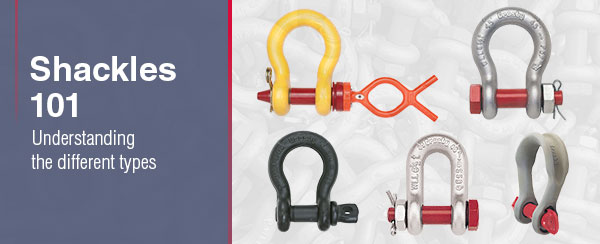Understanding the different types of shackles – the industry workhorse – with Danny Bishop
A shackle is a U-shaped steel connector with holes drilled into the ends for receiving a removable pin or bolt. Shackles are commonly used to connect the slings or load to a winch or crane block, for example. It is one of the most powerful, important, irreplaceable pieces of material handling equipment there is. The shackle “bow” is a word that refers to the U-shaped body of the shackle.
By all definitions, a shackle seems to be a basic, unremarkable piece of everyday equipment. Think about it: when you picture a construction site, what are some of the first images that come to mind? More than likely you think about massive cranes and skeletal structures of I-beams and scaffolding—not a shackle. When it comes down to it though, the cranes couldn’t lift, the I-beams wouldn’t rise, and the construction site would likely be an empty lot without shackles.
Shackles are one of the most versatile, important pieces of equipment in nearly every rigging, lifting, and material handling operation because they serve the critical function of connecting various pieces of lifting equipment to the load. A single shackle can weigh anywhere from an ounce to over four tons and can lift loads exceeding 1,500 metric tons.
Shackles can be found in many industries including:
- Transportation
- Construction
- Land-based energy
- Marine
- Offshore energy
- Entertainment
- Power and utilities
- Cargo handling
- Agriculture
- Forestry
- Oil and gas
- Infrastructure
- Towing
- Mining
Know Your Shackles
Such a powerful piece of equipment requires proper handling and knowledge in order to unleash its full potential. Let’s look at some of the different types of shackle:
Remotely operated vehicle (ROV) shackles
The subsea industry relies on shackles designed specifically for use in underwater operations. These shackles are designed with industry-standard colors to be highly visible by ROV operators and specialized handles to allow for different robotic grips.

Theatrical shackles
They are designed with a black finish that allows them to blend in with stage surroundings. This guarantees behind-the-scene strength and dependability without detracting from on-stage action.
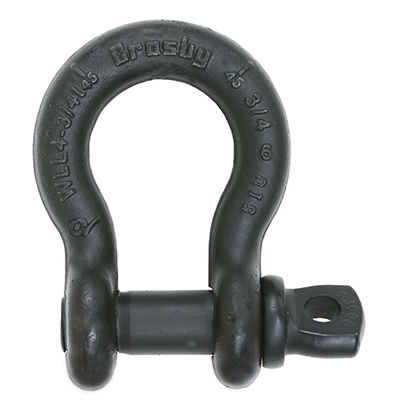
Anchor shackles
When used correctly, anchor shackles enable single or multiple leg slings to be collected in the bow. This level of versatility makes it one of the most widely used shackle types across a variety of material handling applications.
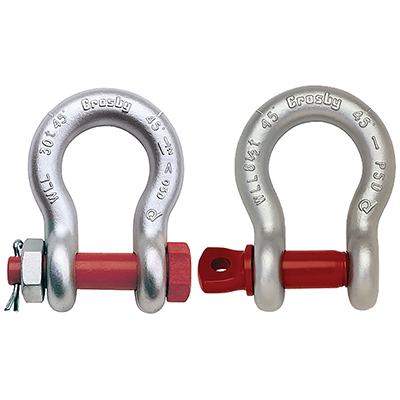
Wide body shackles
They are a specific type of anchor shackle featuring a much wider bow cross-section. The wider shape provides several advantages for heavy lifting applications, including a significant percentage gain in sling bearing surface, which eliminates the need for a thimble. In addition, wide body shackles increase the useable sling strength, which greatly improves the overall life of wire rope slings.
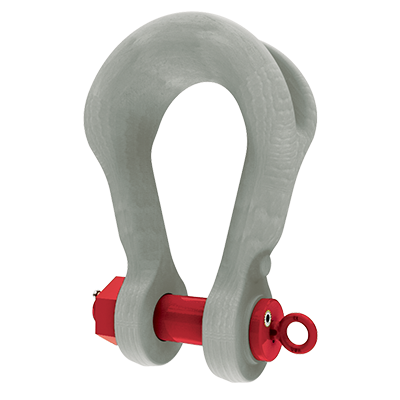
Chain shackles (Dee shackles)
Their design enables efficient movement of materials, particularly in compact lifting environments. Don’t be fooled by the name “chain shackle”—this type of shackle is used primarily with single-legged wire rope slings and various attachment points.

Round pin shackles
They can be used in tie down, towing, suspension or lifting applications where the load is strictly applied in-line. Round pin shackles should never be used in rigging applications to gather multiple sling legs, or where side loading conditions may occur.

Screw pin shackles
They are used in pick and place applications. For permanent or long-term installations, bolt-type shackles are recommended. Screw pin shackles can be used for applications involving side-loading circumstances. Reduced working load limits are required for side-loading applications. While in service, do not allow the screw pin to be rotated by live line, such as a choker application.
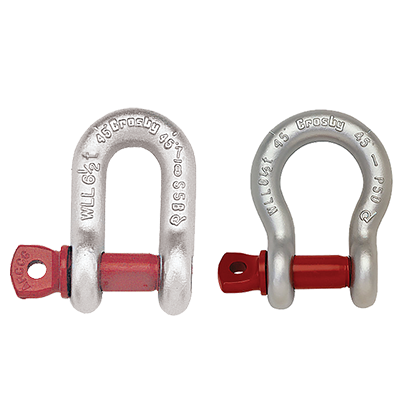
Bolt-type shackles
They can be used in any application where round pin or screw pin shackles are used. In addition, they are recommended for permanent or long-term installations and where the load may slide on the shackle pin causing the pin to rotate. The bolt-type shackle’s secondary securement system, utilizing a nut and cotter, eliminates the requirement to tighten the pin before each lift or movement of load.
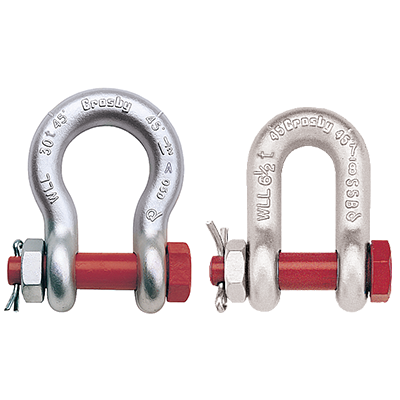
Shackle Application
Proper application of shackles is critical in any material handling situation. The following are some of the most common best practices for shackle applications. While these general practices are a good start, always be sure to check with your manufacturer for the full list of application recommendations and training procedures.
- Always use a bolt-type shackle for permanent / long-term connections.
- Never expose shackles to forces greater than the working load limit.
- Screw pins shall be tightened and fully engaged before each lift.
- If a shackle is designed for a cotter pin, it shall be used and maintained.
- Applied load should be centered in the bow to prevent side loading.
- Multiple sling legs should not be applied to the pin.
- Inspect shackles regularly for damage due to excessive heat, deformation, wear, modifications, cracks, nicks or gouges.
Shackle Inspection
It is imperative that shackles be inspected on a regular basis to ensure that they are suitable for continued use. Shackles must be removed from service if any of the items listed below are visibly found. These defects include, but are not limited to (see ASME B30.26 and manufacturer recommendations for further information):
- Incomplete shackle pin engagement
- Wear or metal loss that exceeds 10% of the shackle bow’s or pin’s original dimension
- Evidence of heat or weld spatter
- Excessive pitting or corrosion
- Any signs of deformation
- Any signs of cracks, nicks and gouges
- 20% or more of the threads are damaged
- Evidence of modification of any kind
- Missing or illegible manufacturing identification
ID and Application
The proper application of shackles requires that the correct type and size of shackle be used. Look closely on the shackle’s bow for the working load limit, its size, a traceability code, and the manufacturer’s name or trademark. Also, do not forget to check the pin or bolt for the name or trademark of the manufacturer, grade, material type or load rating.
Rig safe!
Danny
Danny’s Rigging Den is a blog series written by Danny Bishop, Crosby’s corporate director of value-added training.

